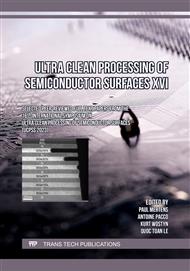p.311
p.318
p.325
p.331
p.335
p.341
p.346
p.351
p.356
Selective Removal of Various Resilient Ionic and Halides-Based Surface Contaminants by Wet Cleaning
Abstract:
In this paper, we investigate the use of a wet cleaner developed to dissolve residues left after plasma etching selectively to aluminum in new applications such as the removal of various resilient ionic and halides-based surface contaminants. The compromise between efficiency and selectivity of this fluorinated acid cleaner makes it an interesting chemistry for many cleaning steps during wafer manufacturing. Two new applications were investigated: the selective removal of fluoride-based defects on aluminum pads and surface decontamination of various ionic metals with low substrate consumption. These studies showed very encouraging results in beakers level tests, but also on partly industrial equipment, opening new possibilities for this cleaner. Indeed, “water lily” defects removal seems to be possible with a low aluminum consumption in TechniClean IK73. Decontamination study carried out in static bath and in single wafer tool showed rather similar results, enabling static bath protocol and ionic metals removal to be validated and VPD-ICPMS results, after a short process time in a single wafer tool were very promising with metal levels close to the lower limit of detection of all elements tested.
Info:
Periodical:
Pages:
356-362
Citation:
Online since:
August 2023
Keywords:
Price:
Сopyright:
© 2023 Trans Tech Publications Ltd. All Rights Reserved
Share:
Citation:


